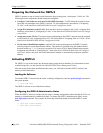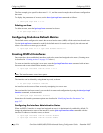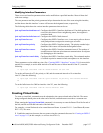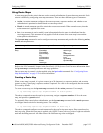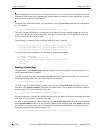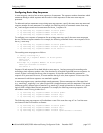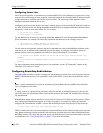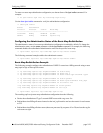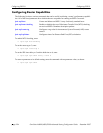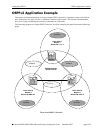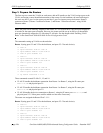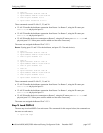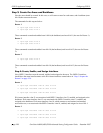
Configuring OSPFv3 Configuring OSPFv3
OmniSwitch 6800/6850/9000 Advanced Routing Configuration Guide December 2007 page 2-21
Configuring Route Map Sequences
A route map may consist of one or more sequences of statements. The sequence number determines which
statements belong to which sequence and the order in which sequences for the same route map are
processed.
To add match and set statements to an existing route map sequence, specify the same route map name and
sequence number for each statement. For example, the following series of commands creates route map
rm_1 and configures match and set statements for the rm_1 sequence 10:
-> ip route-map rm_1 sequence-number 10 action permit
-> ip route-map rm_1 sequence-number 10 match tag 8
-> ip route-map rm_1 sequence-number 10 set metric 1
To configure a new sequence of statements for an existing route map, specify the same route map name
but use a different sequence number. For example, the following command creates a new sequence 20 for
the rm_1 route map:
-> ip route-map rm_1 sequence-number 20 action permit
-> ip route-map rm_1 sequence-number 20 match ipv6-interface to-finance
-> ip route-map rm_1 sequence-number 20 set metric 5
The resulting route map appears as follows:
-> show ip route-map rm_1
Route Map: rm_1 Sequence Number: 10 Action permit
match tag 8
set metric 1
Route Map: rm_1 Sequence Number: 20 Action permit
match ip6 interface to-finance
set metric 5
Sequence 10 and sequence 20 are both linked to route map rm_1 and are processed in ascending order
according to their sequence number value. Note that there is an implied logical OR between sequences. As
a result, if there is no match for the tag value in sequence 10, then the match interface statement in
sequence 20 is processed. However, if a route matches the tag 8 value, then sequence 20 is not used. The
set statement for whichever sequence was matched is applied.
A route map sequence may contain multiple match statements. If these statements are of the same kind
(e.g., match tag 5, match tag 8, etc.) then a logical OR is implied between each like statement. If the match
statements specify different types of matches (e.g. match tag 5, match ip4 interface to-finance, etc.), then a
logical AND is implied between each statement. For example, the following route map sequence will
redistribute a route if its tag is either 8 or 5:
-> ip route-map rm_1 sequence-number 10 action permit
-> ip route-map rm_1 sequence-number 10 match tag 5
-> ip route-map rm_1 sequence-number 10 match tag 8
The following route map sequence will redistribute a route if the route has a tag of 8 or 5 and the route
was learned on the IPv4 interface to-finance:
-> ip route-map rm_1 sequence-number 10 action permit
-> ip route-map rm_1 sequence-number 10 match tag 5
-> ip route-map rm_1 sequence-number 10 match tag 8
-> ip route-map rm_1 sequence-number 10 match ipv4-interface to-finance




